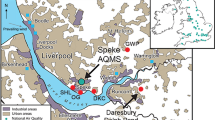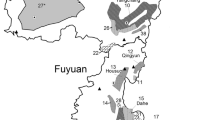Abstract
On the basis of previous observations that: (1) both the nickel (Ni) concentration in ambient air fine particulate matter (PM2.5) and daily mortality rates in New York City (NYC) were much higher than in any other US city; and (2) that peaks in Ni concentration was strongly associated with cardiac function in a mouse model of atherosclerosis, we initiated a study of the spatial and seasonal distributions of Ni in NYC and vicinity to determine the feasibility of productive human population-based studies of the extent to which ambient fine particle Ni may account for cardiovascular health effects. Using available speciation data from previous studies at The New York University, Environmental Protection Agency's Speciation Trends Network; and the Interagency Monitoring of Protected Visual Environments network, we determined that Ni in NYC is on average 2.5 times higher in winter than in summer. This apparent seasonal gradient is absent, or much less pronounced, at NJ and CT speciation sites. Ni concentrations at a site on the east side of Manhattan and at two sites in the western portion of the Bronx were a factor of two higher than at a site on the west side of Manhattan, or at one at Queens College in eastern Queens County, indicating a strong spatial gradient within NYC. We conclude that the winter peaks of fine particle Ni indicate that space heating, which involves the widespread reliance on residual oil combustion in many older residential and commercial buildings in NYC, is a major source of ambient air Ni. Epidemiologic studies based on data generated by a network of speciation sites throughout NYC could effectively test the hypothesis that Ni could account for a significant portion of the excess mortality and morbidity that have been associated with elevated mass concentrations of PM2.5.
This is a preview of subscription content, access via your institution
Access options
Subscribe to this journal
Receive 6 print issues and online access
$259.00 per year
only $43.17 per issue
Buy this article
- Purchase on Springer Link
- Instant access to full article PDF
Prices may be subject to local taxes which are calculated during checkout





Similar content being viewed by others
References
Costa D.L., Lehmann J.R., Winsett D., Richards J., Ledbetter A.D., and Dreher K.L. Comparative pulmonary toxicological assessment of oil combustion particles following inhalation or instillation exposure. Toxicol Sci 2006: 91 (1): 237–246.
Dominici F., McDermott A., Daniels M., Zeger S., and JM S (Health Effects Institute) Mortality among Residents of 90 Cities. Revised Analyses of Time-Series of Air Pollution and Health 2003, 9–24.
Dominici F., Peng R.D., Ebisu K., Zeger SL., Samet J.M., and Bell M.L. Does the effect of PM10 on mortality depend on PM nickel and vanadium content? A reanalysis of the NMMAPS data. Environ Health Perspect 2007: 115: 1701–1703.
EIA. Energy Information Administration, Sales of Fuel Oil and Kerosene 2007. No. DOE/EIA-0535(06). US Department of Energy, Washington, DC.
Ghio A.J., Silbajoris R., Carson J.L., and Samet J.M. Biologic Effects of Oil Fly Ash. Environ Health Perspect 2002: 110: 89–94.
Hedley A., Chau P., and Wong C. The change in sub-species of particulate matter [Pm10] before and after an intervention to restrict sulphur content of fuel in Hong Kong. Better Air Quality/Asian Development Bank Meeting 2004.
Hedley A.J., Wong C.M., Thach T.Q., Ma S., Lam T., and Anderson H. Cardiorespiratory and all-cause mortality after restrictions on sulphur content of fuel in Hong Kong: an intervention study. Lancet 2002: 360 (9346): 1646–1652.
Hsu S.I. Characterization of Exposures to Urban Particulate Matter (PM) and its Components in COPD Patients in New York City and Seattle, Doctoral Dissertation, NYU School of Medicine, Tuxedo, NY, 2008.
Lall R. A Source Apportionment & Time-Series Health Analysis of Fine Particle Air Pollution in New York City. PhD thesis, NYU School of Medicine, Tuxedo, NY, 2008.
Lall R., and Thurston G.D. Identifying and quantifying transported vs. local sources of New York City Pm2.5 fine particulate matter air pollution. Atmos Environ 2006: 40: S333–S346.
Lippmann M., Ito K., Hwang J.S., Maciejczyk P., and Chen L.C. Cardiovascular effects of nickel in ambient air. Environ Health Perspect 2006: 114 (11): 1662–1669.
Maciejczyk P., and Chen L.C. Effects of subchronic exposures to concentrated ambient particles (Caps) in mice: Viii. Source-related daily variations in in vitro responses to Caps. Inhal Toxicol 2005: 17 (4–5): 243–253.
NRC. Oil in the Sea: Inputs, Fates, and Effects. National Academy Press, Washington, DC, 1985, 601pp.
NYSERDA (New York State Energy and Research and Development Authority) In: Wesley C., et al. (Eds.), Petroleum Infrastructure Study—Final Report 2006 (024176000104): pp 107. New York State Energy and Research and Development Authority, Albany, NY.
USEPA. National Trends in Trace Metals in Ambient Air—1965–1974. Office of Air and Waste Management, Research Triangle Park, 1977. No. EPA-450/1-77-003. Washington, D.C.: Government Printing Office.
USEPA. The Clean Air Act 40 1990 CFR 50-88.
USEPA. Compilation of Air Pollutant Emission Factors. Volume 1: Stationary Point and Area Sources. Research Triangle Park, NC, 1995. No. AP-42-ED-5. Washington, D.C.: Government Printing Office.
USEPA. Guidance for Network Design and Optimum Site Exposure for PM2.5 and PM10 1997. No. EPA-454/R-99-022. Washington, D.C.: Government Printing Office.
Acknowledgements
This research was supported, in part, by a Cooperative Agreement from the USEPA (CR 827164), by a Center grant from the USEPA (R 827351), by a post-doctoral training grant for Dr. Peltier from NIEHS (ES 007324), by research grants from the New York State Energy and Research Development Authority (NYSERDA) and the Health Effects Institute (HEI), and utilized support services from an NIEHS Center Grant (ES 00260).
Author information
Authors and Affiliations
Corresponding author
Rights and permissions
About this article
Cite this article
Peltier, R., Hsu, SI., Lall, R. et al. Residual oil combustion: a major source of airborne nickel in New York City. J Expo Sci Environ Epidemiol 19, 603–612 (2009). https://doi.org/10.1038/jes.2008.60
Received:
Accepted:
Published:
Issue Date:
DOI: https://doi.org/10.1038/jes.2008.60
Keywords
This article is cited by
-
Health Risk of Potentially Toxic Elements from Diverse Sources in Urban Road Dust: An Application of Receptor Modeling
Journal of The Institution of Engineers (India): Series A (2022)
-
Tracing local sources and long-range transport of PM10 in central Taiwan by using chemical characteristics and Pb isotope ratios
Scientific Reports (2021)
-
Source apportionment of urban road dust using four multivariate receptor models
Environmental Earth Sciences (2021)
-
Indoor air pollution and respiratory health effects in inner city children with moderate to severe asthma
Air Quality, Atmosphere & Health (2020)
-
Source-specific pollution exposure and associations with pulmonary response in the Atlanta Commuters Exposure Studies
Journal of Exposure Science & Environmental Epidemiology (2018)



